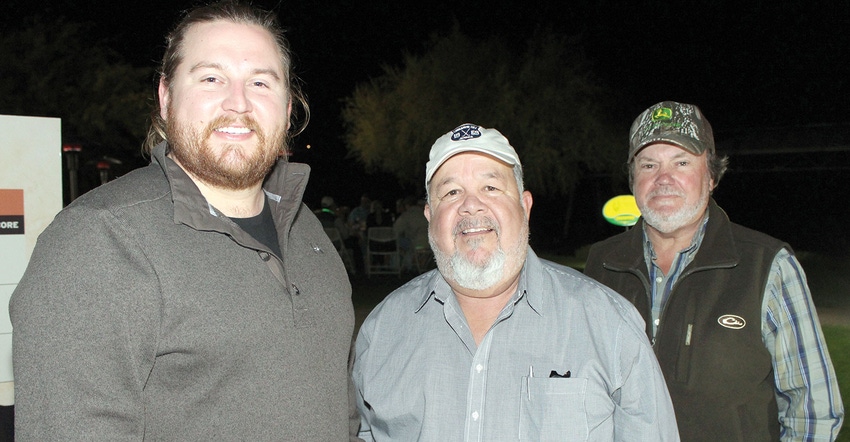
Adversity comes in many forms when you make a living sowing seeds in the ground trying to make a crop year after year. Louisiana’s Terry Mize Jr. closed out his 40th year of farming in 2018. It was another year in the books for Mize Farm that encompasses 6,000 acres of Mississippi River Delta flat ground that stretches across Tensas and Catahoula parishes.
Mize is a third generation farmer. His father, Terry Mize Sr., retired when he was 53, and his grandfather David started the farm back in the 1940s. “Weather was the big obstacle for us this year,” says Mize. “It kept us out of the fields for a while, but we were finally able to get our cotton picked after only a short week’s delay.”
At 60 years old, Mize made his first crop when he was 20 years old. Ninety-percent of his acreage is irrigated via a few pivots and a lot of polypipe, but he plants most of his cotton on dryland ground, saving his irrigated acres for thirsty corn. “The majority of my cotton was DP 1646 B2XF,” says Mize, who has participated in Deltapine’s New Product Evaluator program since it began in 2008.
Bollworm pressure was heavy last year and Mize’s consultant, James Clower, advised control applications of Prevathon twice. “Because I participate in Deltapine’s NPE program, I was able to plant 150 acres to DP 1845 B3XF, that has the additional Bt protein,” says Mize. “We never had to spray it once, and my yield monitor was showing over 3 bales an acre average.”
Willow Dunlow
Mize and first year NPE grower William Dunlow, Dunlow and Dunlow Farms, Gaston, N.C., both grew weary of seeing so much rain in 2018. Dunlow, who started farming with his father, David, in 2013, was not overly concerned about the initial rains – until they kept coming in waves at the end of the growing season and then were followed by high winds from two hurricanes. “Dad and I were looking at a bumper crop, but it ended up being disappointedly sub-par,” says Dunlow. “We also had a lot of hardlock.”
The 5,000-acre Dunlow and Dunlow Farms operation is all dryland. “It wasn’t so dry this year though,” says William, with a sarcastic laugh. “We planted DP 1646 B2XF on most of our cotton acres, but we also grow soybeans, peanuts, and a little corn. We’re thinking about growing some milo this year.
Dunlow is an aspiring pilot who gave up a sales and marketing position in Denver, Colo., after he earned his bachelor of science degree in ag science from North Carolina State University. “I wanted to come back home, work on the farm and learn the subtleties of farming from my father,” says Dunlow. “It’s very fulfilling to work toward the end of each season, and then start fresh again the next year.”
After losing his grandfather in a farming accident, Dunlow starts each day with message of safety to the 10 crew members on Dunlow and Dunlow Farms. “Accidents can happen so quickly. You really have to think ahead and anticipate the unexpected,” says Dunlow.
Gilbert and Diana Casilla
Nobody can predict the future. Gilbert Casillas, and his wife, Diana, who operate Casillas Farms outside of Knox City, Texas, understand that all too well. It was 2013 when they were in Raleigh, N.C., touring Cotton Incorporated when Gilbert had a heart attack.
The husband and wife team farms 2,400 acres and grew cotton seed for Delta and Pine Land Company even before the company was purchased by Monsanto and the name was shortened to Deltapine. “It’s been interesting being a part of this program and seeing how varieties perform in our part of Texas before they might be chosen for commercial release,” says Casillas. “When we planted last year, it was incredibly hot. When Donnie Roberts, our rep, came back to the farm 10 days later, the 105-plus degree weather and 25 mph winds just destroyed many of my cotton acres, including much of my NPE ground.”
Casillas produces his cotton on 32-inch narrow rows in a skip row pattern. “After we replanted what we lost, it came up fine and averaged over 1,300 pounds on my irrigated land,” adds Casillas. “I feel like I have sort of an advantage with my row spacing pattern. I use less seed, my insurance costs are lower, and my yields are very comparable to many operations who are growing cotton on 40-inch rows.”
With only two people working on the farm, Diana helps move equipment around, takes care of the FSA program-related duties and keeps track of all the recordkeeping. “Farming is a good way of life for us,” says Diana Casillas. “Those four days when Gilbert was in the hospital were nerve-racking, but the good Lord carried us both through it. He was actually back playing golf not long after we returned home.”
For three farmers who became friends through a program started to garner grower opinions about potential cotton seed varieties, the NPE Summit is almost like a homecoming each year. They all renew friendships, talk cotton, and share what adversities they may have overcome the previous year in an effort to continue their lives growing what has become the very fabric of it.
About the Author(s)
You May Also Like




